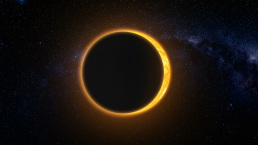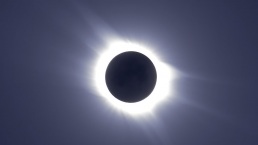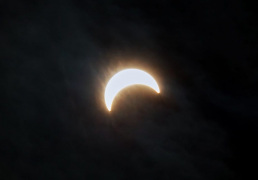Annular Eclipse


During an annular eclipse, the Sun, Moon, and Earth are perfectly aligned, but the moon is at its farthest point away from Earth. This makes the Moon appear too small to block the entire Sun from view. During annularity, the maximum phase of an annular eclipse, only the center of the Sun is blocked making the Sun look like a ring of fire. You can NOT look at the sun at any time without special eclipse glasses or a solar filter during an annular solar eclipse. The Sun is never completely blocked from view.
The next annular eclipse in the United States is October 14, 2023. Click here to determine if you are located on the annular eclipse path. Anyone located near, but NOT on the annular eclipse path, will experience a partial solar eclipse.
Total Solar Eclipse


During a total solar eclipse, the Sun, Moon, and Earth are perfectly aligned. During totality, the maximum phase of the total solar eclipse, the Moon blocks the entire Sun from view. With the Moon blocking the entire Sun, you can see the Sun’s bright outer atmosphere called the corona, which is not usually visible. The Sun’s bright corona looks like soft flower petals surrounding the Moon. During Totality is the ONLY brief time that you can look at the Sun without special eclipse glasses because all of the Sun’s powerful rays are completely blocked.
The next total solar eclipse in the United States is April 8, 2024. Click here to determine if you are located on the total solar eclipse path. Anyone located near, but NOT on the total solar eclipse path, will experience a partial solar eclipse.
Partial Solar Eclipse


During a partial solar eclipse, the Sun, Moon, and Earth are not perfectly aligned. The Moon passes in between the Earth and the Sun and the Moon only blocks part of the Sun from view. During the maximum phase, when the most possible amount of the Sun is covered, only part of the Sun is blocked from view. The Moon only partially blocks the Sun from view making the Sun look like a glowing crescent.
You can NOT look at the sun at any time without special eclipse glasses or a solar filter during a partial solar eclipse. The Sun is never completely blocked from view.
Anyone who is near, but NOT on the eclipse path for either of the upcoming solar eclipses will experience a partial eclipse. Click here to determine if you will experience a partial eclipse on October 14, 2023 or April 8, 2024.
If you didn’t pass the Apprentice quiz the first time, make sure to try again!